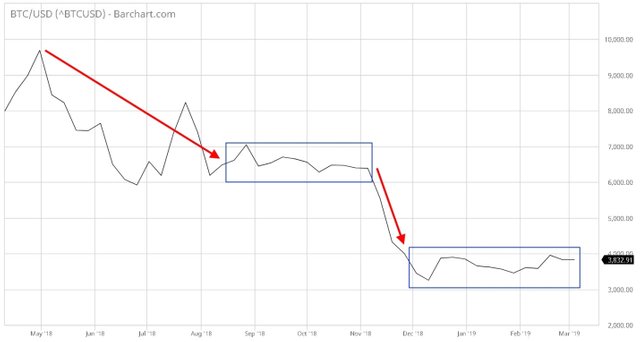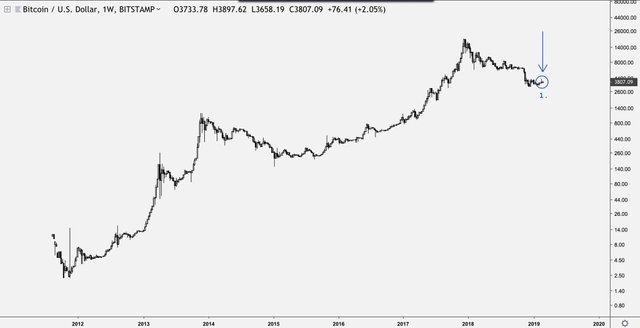IN THE TRENCHES: Bitcoin Searches For Air – READ IMMEDIATELY!

Don’t even try to catch the bottom for Bitcoin. There are hundreds, if not thousands of people out there, who have bought coins, myself included, under $500. There could be a seller out there, ready to liquidate at low prices, at any given time. Last year, from September to November, the crypto market tricked people into thinking that the $6,100 to $6,700 range was the bottom. The next thing you know, Bitcoin slid into the $3,200 to $4,000 range, where it’s trading today.
Bitcoin’s next move could be to resolve lower – this will clear-out speculators by 90%. It’s not likely, but I’ve seen investors vomit before, due to silly-low prices. I love buying when the money is on the floor, just ready for me to pick it up.
I haven’t bought since it surpassed $1,000 in 2017, but my finger is hitching, at this point.

After already suffering an 85% drawdown from $20,000 to $4,000, another leg down in Bitcoin would be cruel and unusual punishment for anyone who bought during 2017’s euphoria.
To eliminate this possibility, we need a clear breakout above the $4,000 level – not a brush with it, or a testing of $4,000 like we saw recently, which was followed by a swift retreat into its current range. The cryptocurrency industry needs a decisive rally. If a strong breakout doesn’t happen in the coming weeks, then the chart pattern would indicate a psychologically uncomfortable move down to the $1,800 level.
The average price drop during the past five Bitcoin corrections was around 85% from the previous all-time high, after which Bitcoin would find a bottom and begin an accumulation phase, so my bet is we don’t reach that sub-$1,500 ever again:

The upside could be tremendous: previous Bitcoin crashes of over 70% have been followed by all-time highs between 5.1 and 16.89 times higher than the previous peak.
Therefore, the next peak could reach anywhere from $102,000 to $336,000. That’s a wide range, but we’re talking in the 5-figure to 6-figure range now. This isn’t the days of the pioneers anymore. Big players are entering. Heck, 35 million people already traded coins. It’s a legitimate industry.
The number of addresses holding one to ten BTC is up by 5% since Bitcoin’s peak in late 2017.
One major catalyst is tokenization. With New York Stock Exchange owner ICE preparing to launch their Bitcoin futures exchange, Bakkt, the NASDAQ doesn’t want to get left behind, so they’re making their own move into crypto.
NASDAQ is the world’s second biggest exchange and it is currently testing out a blockchain-based tokenization platform in Sweden. This development comes right after NASDAQ’s launch in February of two cryptocurrency-based indices: BLX (the Bitcoin Liquid Index) and ELX (the Ethereum Liquid Index).
It also partnered with Symbiont in order to finally grant approval to the elusive Bitcoin ETF that these useless regulators are sitting on for years.
There’s a reason the regulators are scared, though.
The Canadian cryptocurrency exchange platform QuadrigaCX, whose CEO, Gerald Cotton, reportedly died in early December 2018, is one reason for their concern. Cotton’s death was sudden and unexpected, and much to the chagrin of clients who held crypto assets in QuadrigaCX, Cotton’s wife, Jennifer Robertson, said that she didn’t have the private keys to Cotten’s accounts – neither did anyone else, for that matter.
If those private keys aren’t recovered, QuadrigaCX clients who held their assets in the exchange might never recover those assets. QuadrigaCX filed for creditor protection last month, and the company reportedly owes its clients more than $190 million worth of crypto and fiat assets.
The QuadrigaCX case is an object lesson in why it’s not a smart idea to keep large amounts of cryptocurrency assets on an exchange. The exchange’s purpose is, as the name implies, for exchanging (buying and selling) assets, not storing them for long periods of time.
I personally keep my cryptocurrency assets in an external wallet as much as possible, and I keep my private keys in a safe place. Hardware wallets and paper wallets are excellent options for storing large amounts of cryptocurrency that you don’t intend to use on a day-to-day basis.
I also make it a personal policy to never keep more than 5% of my cryptocurrencies on exchanges at any given time. Moreover, I keep more than one copy of my private keys; the last thing I need is my own personal version of the QuadrigaCX private-key-loss incident.
No matter what Bitcoin does from here, keep your crypto SAFE!
Best Regards,
Brad Robbins
President, PureBlockchainWealth.com
Legal Notice:
This work is based on SEC filings, current events, interviews, corporate press releases and what we’ve learned as financial journalists. It may contain errors and you shouldn’t make any investment decision based solely on what you read here. It’s your money and your responsibility. The information herein is not intended to be personal legal or investment advice and may not be appropriate or applicable for all readers. If personal advice is needed, the services of a qualified legal, investment or tax professional should be sought.Please read our full disclaimer at PureBlockchainWealth.com/disclaimer
Original Article Available HERE